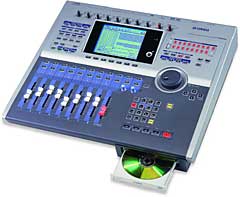AW2816 Digital Audio Workstation (Home Recording Magazine, January 2002)
YAMAHA
by David Darlington
amaha's designs have been at the forefront of digital mixer technology for years, and the company's popular O2R has become somewhat of an industry standard. Soon after it combined a digital mixer, hard disk recorder, and CD burner in the AW4416, the company released the even more affordable AW2816. Aimed specifically at the home studio market and designed for the MIDI-savvy musician, the AW2816 offers an impressive package for the budget-conscious recordist. THE LAYOUT All analog-to-digital conversion is 24 bit, and the internal signal processing is 32 bit, excepting the EQ section, which is 54 bit. Digital connectors (S/PDIF) are provided for connecting DAT machines or other 2-channel devices or for two stereo effect returns for reverbs or other external processors. If you need more inputs, the optional card slot can accept various Yamaha cards that provide eight channels of digital input (ADAT, TDIF, or AES/EBU formats), four channels of analog input, or eight channels of analog. However, the same single-card slot (reduced from two slots on the AW4416) also accepts the new optional Waves Y56K effects card. Yamahas effects are no slouch, but it could be a tough choice deciding between more inputs or the Waves card, which also features eight channels of digital I/O via ADAT Lightpipe. Routing is handled digitally with no signal degradation, and the inputs can be routed to the eight recording buses, six auxiliary buses, the stereo mix bus, and the stereo solo bus. Aux sends 5 and 6 are normaled to the twin internal effects engines, which provide numerous presets similar to those in the well-known SPX series. All channels feature 02R-style 4-band fully parametric EQ and dynamics with an internal library to store your favorite settings. Entire channel strip settings can be stored in the library, along with full console routing setups. Automation is time-based using MIDI Time Code and includes scene changes, fader moves, mutes, and EQ and panning changes. You can tweak just about any parameter you want in real time. The faders are motorized and reflect your mix moves so you can see the actual level of each parameter. Based on my familiarity with my 02R's automation and scene storage, I found the AW2816 to be fairly easy to operate once I located the appropriate menu buttons. In addition to being a versatile console, the AW2816 is a 24-bit 16-track digital hard disk recorder. Each of the 16 dedicated tracks can hold up to eight virtual tracks for a total of 128 recording tracks. There is also a stereo mix-down track, which brings the total to an impressive 130 tracks. Maximum simultaneous recording is limited to eight tracks, and sampling rates of 44.1 and 48 kHz are supported as well as 16-bit recording. No data compression is employed. Routing the inputs to the hard-disk tracks in the quick record window is easy, and the display indicates the routings you have chosen. The virtual transport operates in the tape recorder style familiar to most musicians, with the transport button conveniently located in the lower right-hand corner. (Great for guitarists or bassists recording their own overdubs.) Playback flexibility is augmented by 99 programmable locator points. Drum machines and sequencers can be synced to the AW2816 via MTC, and the recorder can function as either master or slave. As a master, tempo information can be input in the Tempo Map page and stored with the recorded song. Editing is nondestructive, and in addition to the usual cut, copy, and paste function, Yamaha also offers time compression/expansion and pitch change for the audio tracks. If you don't like your edits, you can backtrack with the unit's 15 levels of undo. The 2816 ships with a 20 GB hard disk that provides 150 minutes of 24-bit recording on 16 tracks. According to the manual, you can use any IDE drives with up to 64 GB of storage. The internal software of the AW2816 includes some extra niceties like a drive optimizer and internal calendar to keep track of creation dates for your audio. The internal CD-RW drive lets you master your finished mixes to an audio CD and back up data to inexpensive CD-R media. IN ACTION For most people, especially those making the move from analog to digital systems, the biggest challenge with Yamaha's digital mixers is the learning curve. Almost all the relevant information is displayed in the 2816's LCD, and the organization of information can appear daunting or frustrating to a new user. However, once you understand which windows contain the functions for a given process arming tracks, accessing effects, setting up automation, or any other normal recording actions the 2816 is no more difficult to negotiate than a computer-based recorder. Speed plays a role in two obvious working modes of the 2816: fader automation, which is rapid-fire, and mode changes, which seem to require a waiting period for every action. The latter is frustrating because it would only seem to be a matter of increasing the machine's ROM capacity or operating RAM to effect a more instantaneous response . But this view is shortsighted when you consider everything that the 2816 can do. Its eight analog inputs make it an ideal contender for recording small groups in a live situation. Its 16 tracks give you the power to achieve major label quality recordings, and in fact, its built-in effects are more powerful than those available to engineers a few years ago many of which came from Yamaha rack processors. Its transport and auto-locate functions rival those of dedicated pro recorders, and of course outshine any tape-based systems. But the bottom line is that the sound quality is great, as we found it to be with the 4416 and Yamahas flagship O2R digital mixer. Yamaha had long ago established itself as the leader in effects, digital mixing, and CD-burning technology. You get all that in its workstations. And now you get 16-track recording in a package under $2,500. What's left to worry about the quality of the hard drive? THE RESULTS |
|||||||||||||||
| Originally published in HomeRecording Magazine, January 2002. Posted with permission. All Rights Reserved. |
|||||||||||||||
AW2816 16-Track, 28 Channel Digital Audio Workstation
AW4416 16-Track, 44 Channel Digital Audio Workstation



